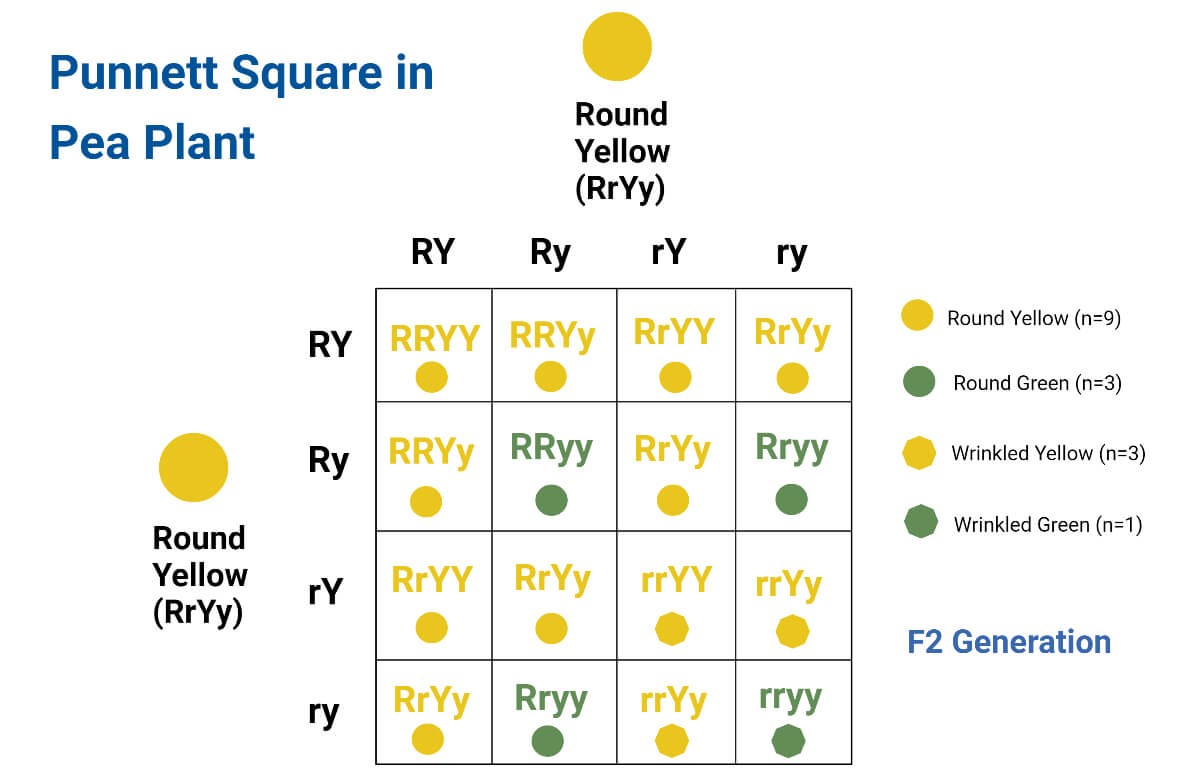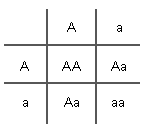Description

Source: Microbenotes
Disclaimer: Copyright infringement not intended.
Context
- The Punnett square is a graphical tool used to predict the possible genetic outcomes of offspring when two individuals with known genotypes are crossed.
- Named after British geneticist Reginald Punnett, who developed the concept in the early 20th century.
Details
Purpose
- Predictive Tool: Helps predict the variations and probabilities of traits in offspring resulting from genetic crosses.
- Visual Representation: Provides a visual representation of possible combinations of alleles from parental genotypes.
Basic Concepts
- Alleles: Different forms of a gene.
- Genotype: The genetic makeup of an individual, represented by letters (alleles).
- Phenotype: The physical characteristics resulting from the genotype.
- Homozygous: When an individual has two identical alleles for a particular gene.
- Heterozygous: When an individual has two different alleles for a particular gene.
Types of Crosses
- Monohybrid Cross: Cross involving one trait.
- Dihybrid Cross: Cross involving two traits.
- Test Cross: Cross between an individual with a dominant phenotype and a homozygous recessive individual to determine the genotype of the dominant individual.

Analysis of Results
- Genotypic Ratio: The ratio of different genotypes in the offspring.
- Phenotypic Ratio: The ratio of different phenotypes in the offspring.
- Probability: The likelihood of a specific genotype or phenotype occurring in the offspring.
Construction of Punnett Square
- Grid Structure: Typically, a 2x2 grid is used, representing the possible combinations of alleles from each parent.
- Allele Representation: Dominant alleles are usually represented by uppercase letters, and recessive alleles by lowercase letters.
- Parental Genotypes: Alleles from one parent are listed along the top row, and alleles from the other parent along the left column.
- Filling in Squares: Each square is filled with the combination of alleles from the corresponding row and column.
Example:
1.


If both parents are carriers of the recessive allele for a disorder, all of their children will face the following odds of inheriting it: 25% chance of having the recessive disorder, 50% chance of being a healthy carrier and 25% chance of being healthy and not have the recessive allele at all.
2.
- Trait: Color of unripe pods in a plant.
- Alleles: Green color (dominant allele 'G'), Yellow color (recessive allele 'g').
- Parental Genotypes:
- Parent 1: GG (Green pods)
- Parent 2: gg (Yellow pods)
- Resulting Ratio: All offspring will have one dominant allele (G) and one recessive allele (g), resulting in green pods with a heterozygous genotype (Gg).
Significance in Genetics
- Understanding Inheritance: Helps understand how genetic traits are passed from parents to offspring.
- Mendelian Inheritance: Used together with Mendel's laws to study patterns of inheritance.
- Application in Research: Commonly used by researchers to study and predict genetic outcomes in various organisms.
Limitations
- Assumes Independent Assortment: Punnett squares assume that alleles segregate independently, which may not always be the case due to genetic linkage.
- Doesn't Account for Environmental Factors: Environmental influences on gene expression are not considered in Punnett squares.
About Mendelian inheritance
- Mendelian inheritance, also known as Mendelian genetics or Mendelism, refers to the principles of inheritance discovered by Gregor Mendel in the 19th century.
- These principles laid the foundation for modern genetics and describe the transmission of traits from parents to offspring.
- Gregor Mendel, an Austrian monk, conducted experiments with pea plants in the mid-19th century, leading to the discovery of fundamental principles of inheritance.
Key Principles:
- Law of Segregation: Each individual has two alleles for each trait, which segregate (separate) during gamete formation, with each gamete receiving one allele. This occurs during meiosis.
- Law of Independent Assortment: Genes for different traits segregate independently of each other during gamete formation, provided they are located on different chromosomes or are far apart on the same chromosome.
Mendelian Inheritance Patterns:
- Dominant-Recessive Inheritance: One allele is dominant and masks the expression of the other (recessive) allele in heterozygous individuals.
- Codominance: Both alleles contribute to the phenotype in heterozygous individuals, without one completely masking the other.
- Incomplete Dominance: Heterozygous individuals display an intermediate phenotype, blending the traits of both alleles.
Examples:
- Seed Shape in Pea Plants: Round (dominant allele, R) vs. Wrinkled (recessive allele, r).
- Flower Color in Pea Plants: Purple (dominant allele, P) vs. White (recessive allele, p).
- Blood Type in Humans: ABO blood group system, with multiple alleles (IA, IB, i) exhibiting codominance and dominance-recessive patterns.

Conclusion
By visualizing possible allele combinations from parental genotypes, Punnett square helps researchers and students alike understand the probabilities of specific traits appearing in offspring. Its application extends beyond classroom learning to research in various fields of biology, contributing to our understanding of inheritance patterns and genetic diversity.
Sources:
Probability of Inheritance
|
PRACTICE QUESTION
Q. The Punnett square is a fundamental tool in genetics that provides a simple yet powerful way to predict the outcomes of genetic crosses. Discuss. (250 Words)
|
















